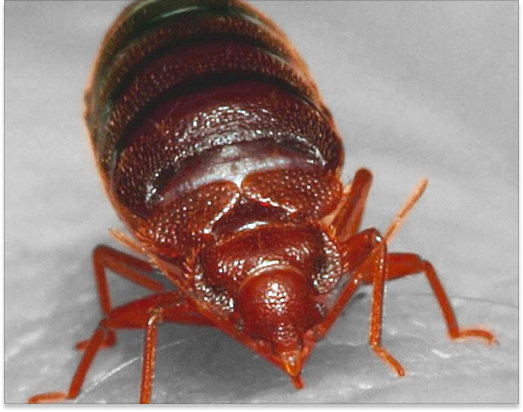Act Now - Limited Time Offer
$67 Pest Control

Jonathan Mitchell
Pest Control Technician
Ty Archer
Pest Control Technician
Mackenzie Keene
Office Manager
Cimex lectularius, better known as the bed bug, is a small, reddish-brown insect that feeds on human blood. These pests are about the size of an apple seed and typically hide in the seams of mattresses, box springs, and furniture cracks. Bed bugs are nocturnal and can conceal themselves in small areas like fabric folds, electrical outlets, and picture frames.
Bed bugs progress through five stages before reaching adulthood, needing a blood meal to move from one stage to the next. Females can lay up to five eggs each day in hidden areas. Bed bugs can survive for several months without feeding. Although they don’t transmit diseases, their bites can cause itching and allergic reactions.


Cimex Hemipterus, a species of bed bug, is commonly found in tropical and subtropical regions. Like its more widespread cousin, Cimex lectularius, this bed bug feeds on human and animal blood. They are small, reddish-brown insects, about 4-5 mm long, with oval, flattened bodies that make them good at hiding in small spaces.
Primarily active at night, Cimex hemipterus can also feed during the day, especially in hot or dry conditions. They often nest near water to ensure their larvae have sufficient moisture. To detect an infestation, look for these bugs near your bed or other resting places. Signs include tiny red blood spots on your sheets, brown fecal streaks, and shed skins.
Leptocimex Boueti bed bugs can become a significant problem if they infest your living space. These pests mainly feed on humans at night but will come out during the day if it is too hot or dry. They prefer living near water sources to ensure their larvae have access to water, although they are not aquatic.
Adult Leptocimex Boueti bed bugs are about the size of an apple seed, with a flat, oval body that is reddish-brown and darkens after a meal. They have long antennae and compound eyes that resemble raspberries. With three pairs of legs, their bodies can expand significantly when feeding. If you suspect bed bugs in your home, it is essential to act quickly. Sheldon Pest Control offers solutions to eradicate these pests and prevent future problems.

The eggs of bed bugs are tiny, around 1mm in length, which makes them hard to see. They are pearl-white, allowing them to blend with light-colored surfaces. After five days, an eye spot may become visible on the eggs.
Bed bugs prefer to lay their eggs in hidden, secure areas near where they feed. These include mattress seams, crevices in box springs, and spaces beneath baseboards. Female bed bugs can lay up to five eggs daily, with hatching occurring in 4-12 days. If not handled properly, these eggs can result in new infestations.


Bed bug nymphs are young bed bugs that go through five growth stages before they become adults. These nymphs are smaller and lighter in color compared to adults, making them harder to see. Each stage of development requires a blood meal to molt to the next, usually taking 5-10 minutes.
Nymphs are often found hiding near sleeping or resting areas, like mattress seams, bed frames, and small crevices. Signs of nymphs include tiny pale bugs and small blood spots on sheets. Effective treatment targets these areas to eradicate all nymphs.
Adult bed bugs are small, reddish-brown insects about the size of an apple seed. Their bodies are flat and oval but swell after feeding. These pests feed on human blood and are most active at night, biting sleeping people.
Bed bugs typically hide in places close to sleeping areas, such as mattress seams, bed frames, and nearby furniture. They can also be found behind outlets and picture frames. Signs of a bed bug infestation include tiny red blood spots, brown fecal stains, and discarded skins. Regularly inspecting these areas can help identify and manage bed bug problems early.

Sheldon Pest Control begins the bed bug treatment process with a thorough inspection by our certified inspectors. They detect bed bugs through photos or signs and provide a preparation sheet with detailed steps. Customers must prepare by removing wall decorations, vacuuming infested areas, and laundering bedding and clothing. Our technicians treat the entire room, focusing on furniture footings, moldings, cracks, crevices, bed frames, headboards, box springs, and mattresses. The black covering under the box spring needs to be removed to ensure effective treatment. Treated areas should stay empty for at least three hours.
Depending on the infestation’s extent, we suggest 3-4 treatment sessions. The cost is calculated following the inspection. Our treatments are pet-safe, although we recommend vacating the premises for 3-4 hours during and after treatment. We offer a 30-day warranty for comprehensive home treatments. Following our preventive measures and maintaining cleanliness can help prevent reinfestation. Our targeted and effective strategies guarantee the total elimination of bed bugs, giving our clients peace of mind.


We offer a complimentary follow-up service two weeks after the initial bed bug treatment. This follow-up includes using an insect growth regulator to stop the life cycle of bed bugs, ensuring any leftover eggs or nymphs are dealt with to prevent them from growing into adults.
Our technicians will revisit and inspect the treated areas for any signs of bed bug activity. This extra check offers an added layer of protection and reassurance. With our follow-up, you can be sure that we are dedicated to completely removing bed bugs from your property.

Limited time offer! Get $50 off your first pest control service.

Barrier Services
Sheldon Office
© Sheldon Pest Control 2024